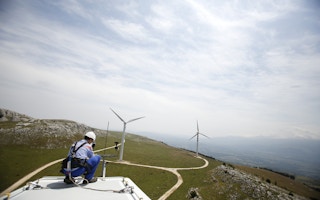In the face of Europe’s energy crisis, political and economic leaders in Italy, the European Union’s third largest economy, are confronting two opposing forces. On one hand, there is fear of change, which leads policymakers to fall back on old solutions: drilling, new gas pipelines and gasifiers, and efforts to secure hydrocarbons in Africa and the Middle East. On the other hand, there is pressure for innovation from the electricity industry and all those sectors of society that see this crisis as a clear signal that the fossil fuel era is ending.
The conflicting views of Italy’s political and economic establishment mirror the divisions within Italian society. A recent SWG survey shows that the debate about energy issues is rarely based on hard evidence, but rather on biases and perceptions that are related more to age than political affiliation. Italians over 55 seem to be stuck in the past: 33 per cent, for example, believe that renewable energy has never exceeded 10 per cent of Italy’s total electricity production. Only 7.5 per cent of this cohort came close to the real figure: today, Italy produces about 40 per cent of its electricity from renewable sources. Young people under 24 are better informed: the share of those who correctly evaluate the contribution of renewables to electricity production is three times higher, at 22 per cent.
Italians over 55 seem to have forgotten the country’s impressive tradition of renewables. Few remember the avant garde hydroelectric turbines that, since the beginning of the twentieth century, fed the electro-steel plants of Sesto San Giovanni with water flowing from the Alps; or Larderello, the world’s first geothermal power plant, in Tuscany. Similarly, few people seem to know that Italy is a world leader in solar power, or that the state owned company ENEL Green Power is one of the five largest solar companies.
In 2014, Italy also briefly held the world record in solar energy use, which at the time accounted for 8 per cent of the country’s total electricity consumption. The same year, Italy was among the first of the European Union’s member states to reach the transition targets set by the EU for 2020, and it did so well in advance of that date. But the SWG survey shows that 94 per cent of Italians over 55 do not know this; on the contrary, they think that Italy has missed the targets.
Despite these early successes, Italy has slipped to 12th place among EU countries in renewable electricity production. In terms of efficiency, Italy still leads the continent’s large economies in terms of energy consumed per unit of GDP, but its competitive advantage is shrinking. In 1995, the Italian economy was 32 per cent more efficient than the EU average; by 2019, this margin had dropped to 11 per cent.
As the SWG survey shows, Italians under 35 are more aligned with the technological realities of the twenty-first century. They are also the most informed about renewables and the most enthusiastic supporters of the green energy transition. But the over-55s far outnumber these “renewable natives.” Having grown up in the golden age of fossil fuel technologies, they know little about renewables and are more likely to underestimate their returns and overestimate their costs.
It is still too early to predict how the new government will reconcile these contrasting perspectives. For now, fossil fuel nostalgia and the desire to slow down the energy transition seem to have prevailed. But Italy has an industrial revival plan the likes of which it has not produced in decades. While the Marshall Plan, led by the United States, promoted hydrocarbons and the motorization of Baby Boomers in the 1950s, the new energy transition plan to build efficient transport, housing, and production systems that are integrated with the biosphere and the atmosphere is ours – designed by us and for us.
In terms of levelised cost of energy (LCE), renewables are the least expensive sources available. The greatest cost is the initial infrastructure investment, after which the source – water, sun, wind, or geothermal energy – is free. Of course, the transition also requires raw materials, reliable business partners to supply them, and industrial capacity to manufacture blades, panels, control units, and nets. But Italy has everything it needs to face this challenge. As the second largest manufacturer in the EU, Italy does not lack production capacity. And dependence on metals and rare earths will be reduced with improved recycling technologies, a sector in which Italy is also at the forefront.
The energy crisis has highlighted how energy systems based on fossil fuels create dependence on petrostates, which can then blackmail other countries by threatening to turn off the tap. Italy is currently attempting to replace Russian gas with supplies from unstable countries, many of them in the grip of violent conflict. By doing so, Italy could become the new hub for trans-Mediterranean gas traffic, as Ukraine was for gas deliveries from Russia to Europe. Is that really what Italians want?
Historically, Italy enthusiastically embraced energy innovation. In the late nineteenth and early twentieth centuries, it was among the leading countries in electrification and among the first to abandon petroleum derivatives in favor of cleaner and more efficient methane. Today’s Italians have an opportunity to revive this tradition and shift to the most advanced, efficient, and cheapest forms of energy currently available: renewable sources. To seize it, however, Italy’s young people will have to educate their parents.
Gianluca Ruggieri, an environmental engineer, is a researcher in environmental technical physics in the Department of Theoretical and Applied Sciences at the University of Insubria and Founder of Ènostra, a cooperative of renewable energy producers and consumers.
Copyright: Project Syndicate, 2022.www.project-syndicate.org









